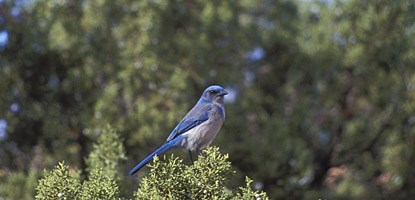
NPS/Martin Tow Birds are the most visible animals in Arches. Even on the hottest summer day, turkey vultures, ravens, and white-throated swifts circle above the rock formations. During winter, juncos and white-crowned sparrows forage around trees and shrubs. While Arches may not be considered a bird watching hot spot, nearly 200 species have been seen in the park, including seasonal and year-round residents as well as migrants. Arches owes much of this diversity to riparian corridors like Courthouse Wash and the Colorado River (which forms the park’s southern boundary). In the desert, animal life tends to concentrate around riparian areas because of the abundance of food, water and shelter. During spring and summer, songs from birds like blue grosbeaks, yellow-breasted chats, spotted towhees, and canyon wrens fill these areas. You might see great blue herons hunting the shallows for fish, while Cooper’s hawks deftly maneuver through the tangle of trees beyond the riverbanks. 
NPS/Neal Herbert Many birds favor the “upland” areas where grasses, shrubs and small trees dominate. Say’s phoebes, black-throated sparrows and western meadowlarks frequent grasslands. Pinyon jays, scrub jays, juniper titmice and black-throated gray warblers are usually seen in pinyon-juniper woodlands. Since they can fly, it is difficult to generalize about what birds will be found in a particular habitat. However, regardless of habitat or season, the common raven figures prominently in the desert landscape. Ravens are intelligent birds that, according to scientists, display abilities to play and problem-solve that are rare among animals. This jet-black member of the crow family is also very vocal, using a variety of sounds for communication. Perhaps because of these qualities, ravens have achieved a certain stature in both European and Native American folklore. Arches monitors bird populations at several selected locations in both upland and riparian areas. Some surveys count all birds, while others focus on birds that actually nest in the park, such as peregrine falcons. Findings from these surveys and others like them are used to monitor the health of local bird populations and estimate species richness throughout the country.
For a complete list of native birds, check out our species list.
Read More |
Last updated: July 29, 2021
